FLEA BETS, OR EARTH FLEAS

With the heatwave, the flea beetles are having a field day.
It is in fact in these particularly hot and dry conditions that this insect proliferates.
With good eyesight (flea beetles measure less than 5 mm), you may be able to observe these little creatures jumping like fleas from cabbage to cabbage for example.
But their presence is mainly characterized by leaves riddled with small holes...
Before seeing how to avoid flea beetle damage to our crops, let's start by getting to know this insect a little better.
PRESENTATION OF THE ALTISE
The flea beetle (subfamily Alticinae) is a small beetle insect measuring 1.5 to 5 mm depending on the species.
There are different species, varying in size and color, but having the following in common:
- highly developed hind legs, allowing them to make long jumps, hence their nickname earth fleas.
- long antennae, useful for locating their favorite foods
- wings, hidden under elytra, which allow them to travel several hundred meters to taste these dishes...
Each species has its host plant (or species of host plant).
Here are the main species found in vegetable gardens in France, and more widely in Europe:
Cruciferous flea beetle or cabbage flea beetle
(Phyllotreta nemorum)
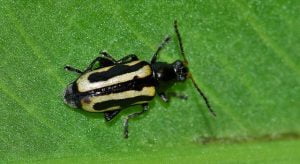
Measuring 3 or 4 mm, with a black carapace streaked with large yellow bands. It mainly attacks plants of the cruciferous family (brassicaceae today…): cabbage, radishes, turnips, arugula, rapeseed, mustard…
Rapeseed flea beetle
(Psylliodes chrysocephala)
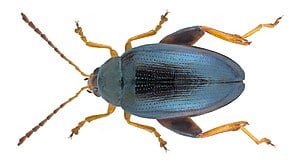
Its shell is blue-black and shiny. The adult measures between 4.5 and 5 mm. Although preferring rapeseed, it also appreciates other plants in the cruciferous family.
Beet flea beetle
(Chaetocnema_concinna)
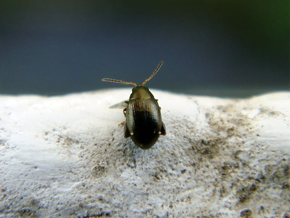
Measuring less than 2.5 mm, with a dark, slightly greenish shell. It attacks beets, chard, but also sorrel or even spinach.
Potato flea beetle
( Psylliodes affinis)
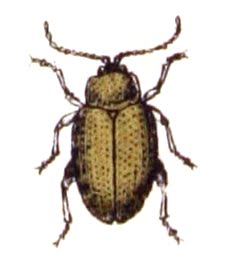
Equipped with straw-yellow elytra and measuring 2 or 3 mm, it attacks the foliage of potatoes and more rarely other nightshades (tomatoes, eggplants, peppers).
WHAT DAMAGE IS CAUSED BY FLEA BEETLES ON OUR CROPS?
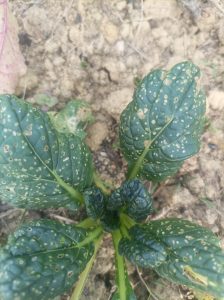
Flea beetles like warm and dry situations (which will help us below).
Also, the “attacks” are especially observable in the middle of summer.
But they can start in spring (more or less early depending on the weather) and last until autumn (this also varies depending on the weather, but also on the species).
The flea beetle gnaws the leaves of its host plants, riddled them with small rounded holes.
Apples (headed cabbages) or inflorescences (cauliflowers, broccoli cabbages, Romanesco cabbages) can also be affected.
When they are virulent, these attacks will have the following consequences:
- a weakening of the plant (the tissues being seriously damaged, the leaf may end up drying)
- disrupted development (less healthy leaf surface = less photosynthesis)
- reduced harvests, and above all depreciated (plant no longer very presentable... even if it remains perfectly edible)
HOW TO PROTECT YOUR CROPS FROM FLEA BEETLES?
Preventively
- Promote biodiversity within your garden, by installing hedges (for birds or hedgehogs in particular), by digging a pond (in order to accommodate amphibians, fond of flea beetles), by installing piles of stones (reptiles ) or quite simply by preserving wild areas…
- Keep the soil cool, especially with a good mulching, but also by watering (early morning or late evening) possibly more often than usual if the weather is conducive to a proliferation of flea beetles
- Plant repellent flowers (marigold, cosmos) here and there in your vegetable garden
- Plant salads in association with cabbage, turnips, radishes
- As a preventative measure, if conditions are favorable, spray a decoction of tansy flowers
- Place, within sensitive crops, branches of repellent plants such as broom or rosemary in particular
- Place an anti-insect protection net, with very fine mesh (2 mm)
How to keep flea beetles away from crops?
- Water the foliage of sensitive plants either with a fine rain spray (the flea beetles will look elsewhere, but will return a few hours later... start again until you discourage them)", or with a more aggressive spray (the message is immediately more clear… but avoid doing it on fragile plants)
- Spray a decoction of tansy flowers
- Spray some Undiluted wormwood manure (preferably prepared with dry leaves)
- Water with a cabbage leaf slurry, for which here is the recipe:
- In a plastic container, macerate 3 kg of fresh, well-colored leaves in 10 liters of water
- Cover leaving ventilation
- Stir every day until the bubbles disappear
- Filter
- Water the base with manure diluted 5 times (i.e. 1 liter of manure for 5 liters of water) every 3 or 4 days as long as you see flea beetles (or new damage)
And at home, are your crops affected?
How do you react ?
Do you have any tips or recipes to share?
.




































